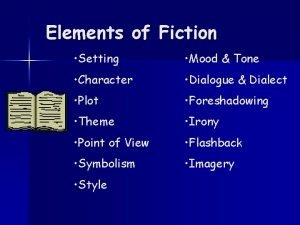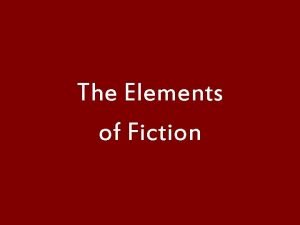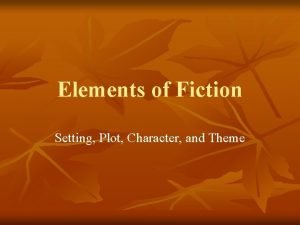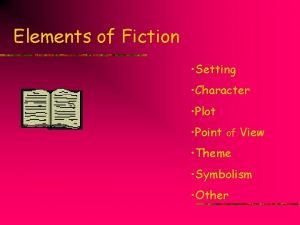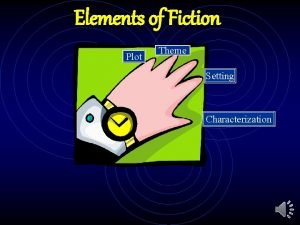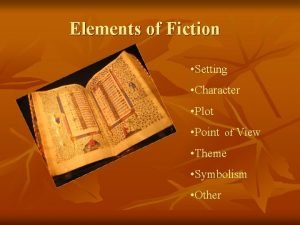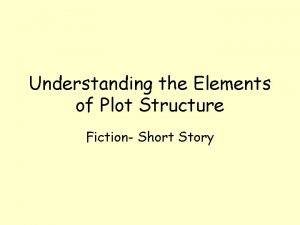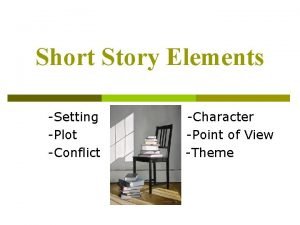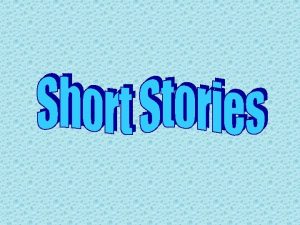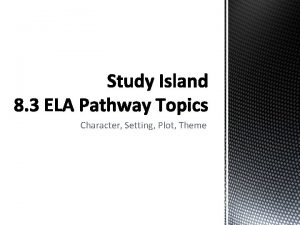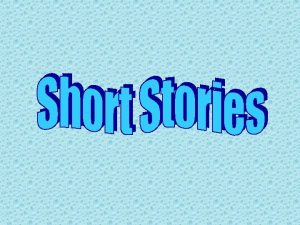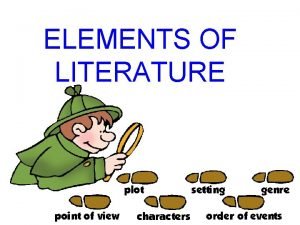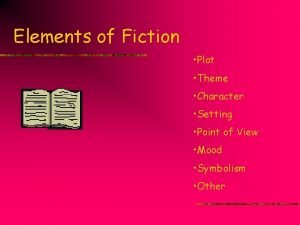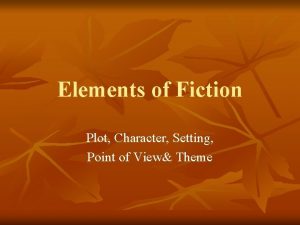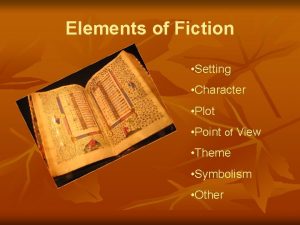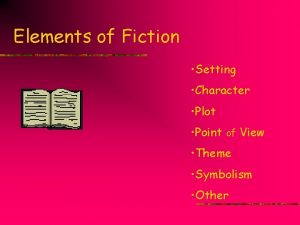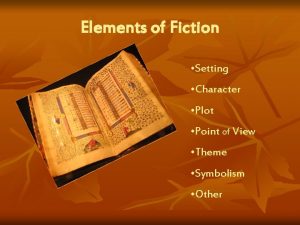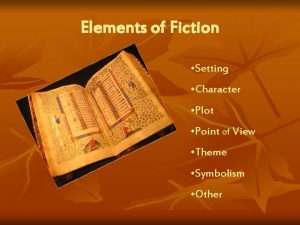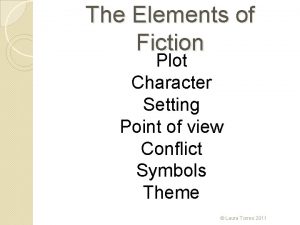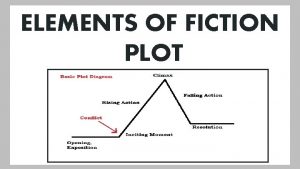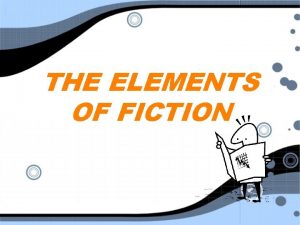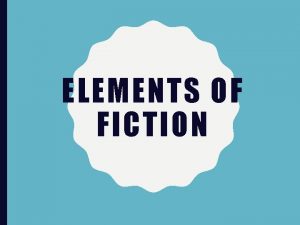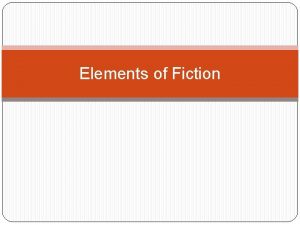Elements of Fiction Setting Character Plot Point of


















- Slides: 18



Elements of Fiction • Setting • Character • Plot • Point of View • Theme • Symbolism • Other

Setting- the time, place and period in which the action takes place. It includes : The geographical location The specific location building, room, etc. The time period The socio-economic characteristics of the location

Setting- helps in the portrayal of characters. “I write this sitting in the kitchen sink. That is, my feet are in it; the rest of me is on the draining-board. " I capture the Castle by Dodie Smith “Sir Walter Scott the Younger of Buccleugh was in church marrying his aunt the day the English killed his granny. " Dorothy Dunnett Disorderly Knights

Setting- establishes the atmosphere of a work. It Was a Dark and Stormy Night… Snoopy "It was the best of times, it was the worst of times. . . " A Tale of Two Cities

Characters- The people (or animals, things, etc. presented as people) appearing in a literary work. Protagonist The main character in a literary work. Antagonist The character who opposes the protagonist.

Character Types • Round Character: convincing, true to life and have many character traits. • Dynamic Character: undergoes some type of change in story because of something that happens to them. • Flat Character: stereotyped, shallow, often symbolic. They have one or two personality traits. • Static Character: does not change in the course of the story

Methods of Characterization • direct- “he was an old man… • characters’ thoughts, words, and actions • reactions/comments of other characters • character’s physical appearance • characters’ thoughts

Plot the series of events and actions that takes place in a story. Climax: The turning point. The most intense moment (either mentally or in action. Rising Action: the series of conflicts and crisis in the story that lead to the climax. Exposition: The start of the story. The way things are before the action starts. Falling Action: all of the action which follows the Climax. Resolution: The conclusion, the tying together of all of the threads.

Elements of Plot • Conflict • Man VS Man • Man VS Nature • Man VS Society • Man VS Himself

Point of View: The perspective from which the story is told. (Who is telling the story? ) Omniscient Point of View: The author is telling the story. Limited Omniscient: Third person, told from the viewpoint of a character in the story. First Person: Story is told from point of view of one of the characters who uses the first person pronoun “I. ”

The Theme of a piece of fiction is its central idea. It usually contains some insight into the human condition. The Literary Element of Theme • a general statement of the central, underlying, and controlling idea or insight of a work of literature. • the idea the writer wishes to convey about the subject—the writer’s view of the world or a revelation about human nature. • can be expressed in a single sentence. Theme is NOT • expressed in a single word • the purpose of a work • the moral • the conflict

The Literary Element of Theme Identifying the Theme in Five Steps To identify theme, be sure that you’ve first identified the story’s plot, the way the story uses characterization, and the primary conflict in the story. 1. Summarize the plot by writing a one-sentence description for the exposition, the conflict, the rising action, the climax, the falling action, and the resolution. 2. Identify the subject of the work. 3. Identify the insight or truth that was learned about the subject. • How did the protagonist change? • What lesson did the protagonist learn from the resolution of the conflict? 4. State how the plot presents the primary insight or truth about the subject. 5. Write one or more generalized, declarative sentences that state what was learned and how it was learned. Theme Litmus Test • Is theme supported by evidence from the work itself? • Are all the author’s choices of plot, character, conflict, and tone controlled by this theme?

Symbolism- A symbol represents an idea, quality, or concept larger than itself. A Journey can symbolize life. Water may represent a new beginning. Black can represent evil or death. A lion could be a symbol of courage.

Other Fiction Elements • Allusion: a reference to a person, place or literary, historical, artistic, mythological source or event. “It was in St. Louis, Missouri, where they have that giant Mc. Donald’s thing towering over the city…”(Bean Trees 15) • Atmosphere: the prevailing emotional and mental climate of a piece of fiction. • Dialogue: the reproduction of a conversation between two of the characters.

Other Elements • Foreshadowing: early clues about what will happen later in a piece of fiction. • Irony: a difference between what is expected and reality. • Style: a writer’s individual and distinct way of writing. The total of the qualities that distinguish one author’s writing from another’s. • Structure: the way time moves through a novel. • Chronological: starts at the beginning and moves through time. • Flashback: starts in the present and then goes back to the past. • Circular or Anticipatory: starts in the present, flashes back to the past, and returns to the present at the conclusion. • Panel: same story told from different viewpoints. (Lou Ann and Taylor chapters in The Bean Trees.

The End
 Element of non fiction
Element of non fiction Tone character
Tone character Elements of fiction setting
Elements of fiction setting Elements of fiction setting
Elements of fiction setting Elements of fiction setting
Elements of fiction setting What is the theme
What is the theme Element of fiction setting
Element of fiction setting Elements of fiction setting
Elements of fiction setting Elements of fiction plot diagram
Elements of fiction plot diagram Fiction meaning
Fiction meaning Short story english with setting characters and plot
Short story english with setting characters and plot Plot setting characters
Plot setting characters The lion and the mouse plot elements
The lion and the mouse plot elements Short story with characters, setting, and plot
Short story with characters, setting, and plot Hatchet plot diagram
Hatchet plot diagram Short story definition in literature
Short story definition in literature Theme elements of fiction
Theme elements of fiction It is a genre of speculative
It is a genre of speculative Contemporary realistic fiction vs historical fiction
Contemporary realistic fiction vs historical fiction

